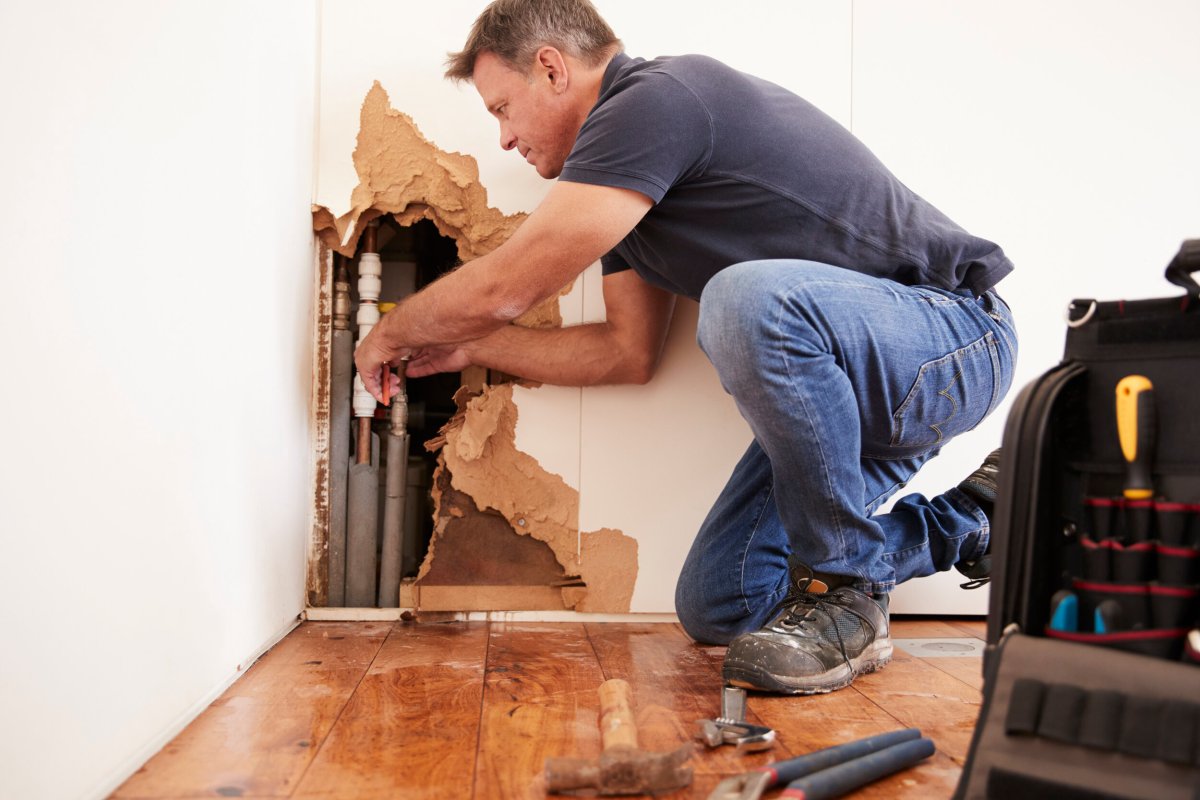We may earn revenue from the products available on this page and participate in affiliate programs. Learn More ›
Chances are there will come a time when you’ll have to turn off the water supply to your home. You may need to do so for a scheduled plumbing repair, or before leaving on a long trip. Then there are the emergency situations, such as when a pipe bursts somewhere behind the drywall or your bathroom is flooded with water, when you’ll need to cut the water off, and fast. Even if repairs or emergencies haven’t come up yet, it’s still important to know where your home’s main water valves are and how they function. Closing and reopening them periodically will prevent them from getting stuck in place, and give you an opportunity to inspect them for corrosion or broken connections.
There’s no one universal spot in every house where water supply valves are located, so it could take some time to find them—time that you won’t have if water is rapidly soaking through the second-floor ceiling. Before there’s any urgency (or water all over the floor) at your place, consider familiarizing yourself now with how to turn off the water supply. Show family members, too, where the valves are and how to cut them off quickly. This knowledge will make regular maintenance easier, and it could save you hundreds or even thousands of dollars in repair costs in a worst-case scenario.
Project Overview
Working Time: 10 minutes
Total Time: 30 minutes
Skill Level: Beginner
Estimated Cost: $0
Types of Water Valves

There are a wide variety of valves that are used in commercial, industrial, and institutional plumbing scenarios. However, there are two types of valves that are commonly used in residential homes as building control valves: gate valves and ball valves. In residential settings, these valves tend to range in size from ½ inch to 1½ inches, and they can be maneuvered by hand without using any tools.
- Gate valves consist of a circular handle attached with a stem to the body of the valve. When you turn the handle, it slowly closes a gate inside the body of the valve, blocking the flow of water. Turning the valve in the opposite direction will open the gate and allow the water to flow freely.
- Ball valves are the preferred type of valve for home use because they are less likely to seize up or develop leaks over time. You can recognize ball valves by their lever-style handle. As the name indicates, there is a ball inside the body of the valve that has a hole through the center. When the valve is open, the handle should be in line with the pipe, allowing the water to flow through the hole in the ball. Turning the valve 90 degrees, so that it is perpendicular to the pipe, will rotate the ball to the side so that water cannot flow through the hole.
How to Find the Water Shut-Off Valve to Your Home
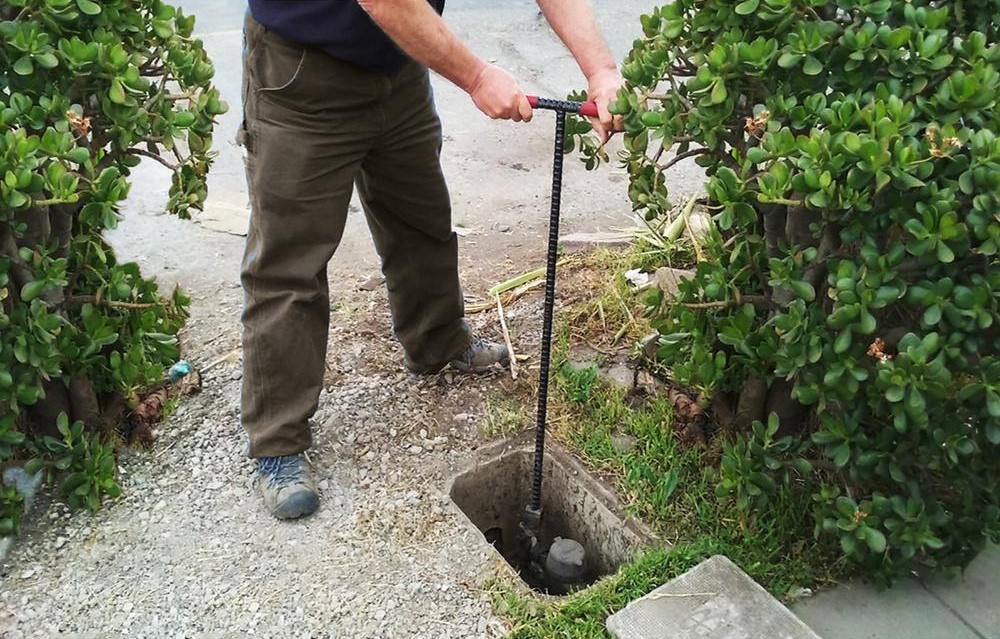
The main water shut-off valve is usually located on the main water line, where it enters the home. In most cases, this will be in a basement, cellar, or crawl space because the water line extends from the neighborhood water main and enters the home from under the ground. In warmer areas where freezing pipes aren’t a concern, the main water shutoff might also be found outdoors on an exterior wall, or buried near the street.
Look in these areas for your home’s main water valve:
- Inside the house. Water supply pipes from the city typically run from the street side of your house to the indoors. So check out utility areas—such as the garage, laundry room, or basement—along exterior walls facing the street. A likely place to start looking is near your water heater. In a basement, the pipe will likely be at eye level; on main floors, it will often be located lower down.
- Outdoors on an exterior wall. In some warmer climates, the shut-off valve may be located outside the home on an exterior wall. Start looking for it near your outdoor faucet.
- Outdoors buried near the street. If you can’t find the valve in or around the house, it’s time to hit the street. There’s usually a water supply shut-off valve next to your water meter outside where the city can easily turn your water on or off. It will likely be below an access panel buried in the ground, near the street. The access panel may require a special tool called a water meter key (sold online and at most hardware stores) to remove the cover. There may be two valves: one for the homeowner (on the side of the water meter closest to the house) and one for the city (on the side of the water meter closest to the street). Or there may just be one valve, which is for the city’s use. It may not be permitted for homeowners to use this valve, so it’s best to confirm with your water utility company.
Step 1: Locate the valve.
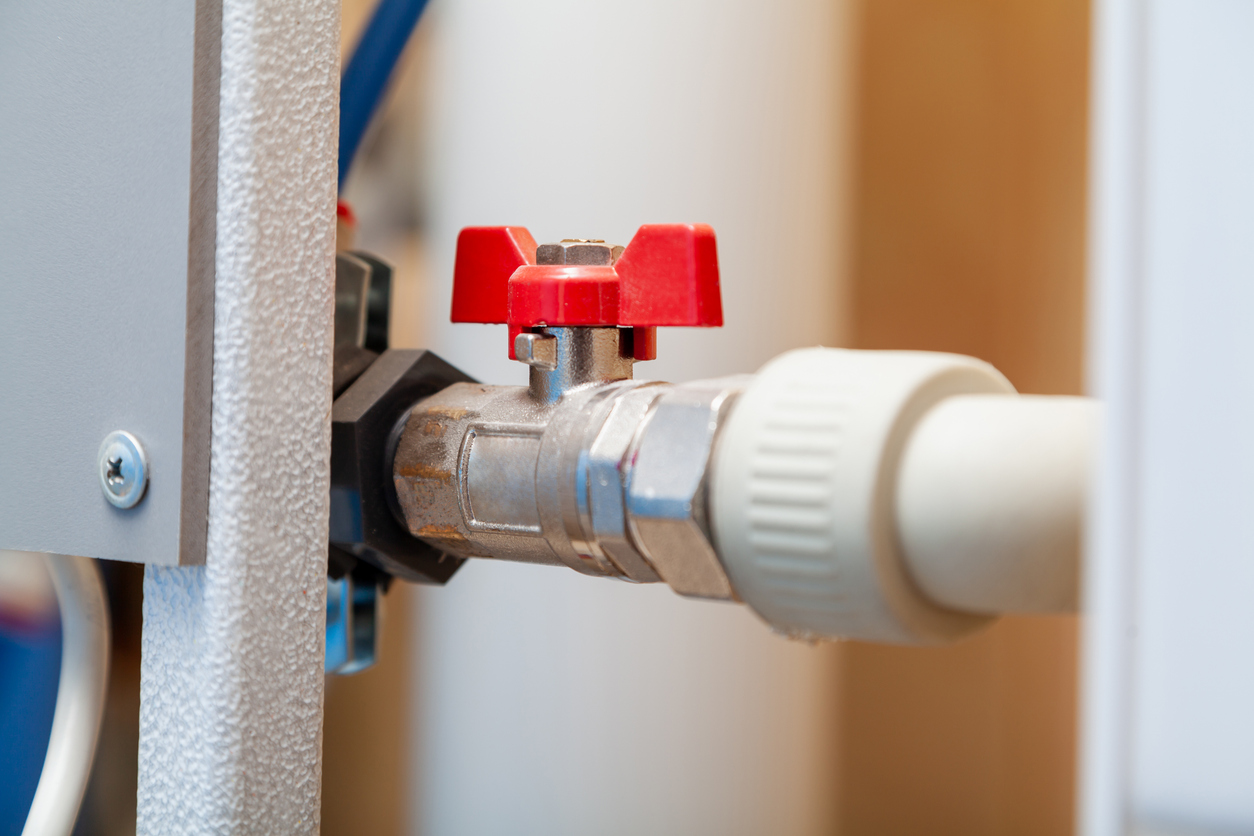
The water main shut-off valve could be in a number of places, depending on the age of your home and the climate of your location. Valves can sometimes be buried inside drywall or behind the furnace. If your valve is in one of these tight locations, you may need a professional plumber to relocate the valve or to install an easy-to-access secondary valve further down the line. The shutoff will either be a gate valve, which looks like a circular spigot, or a ball valve, which has a lever-style handle.
When you find it, take some time to inspect the valve for any problems. If the valve is rusted, aged, significantly worn, or if you spot a leak, then you are better off contacting a plumber to replace it instead of taking a risk on an unreliable valve that may break if you attempt to use it.

Tried-and-True Advice
There have been two times when I’ve had to turn off the water in my home quickly: One was a burst frozen pipe in an unfinished part of the house. Another was when I was constructing a built-in and happened to drill right through a water supply line hidden in the wall. In both cases, I found myself scrambling to locate the water shut-off valve as a geyser of water sprayed from the wall.
Even if you’ve had to shut off the water in your home before, panic can make it difficult to remember where it is. Once you do locate the main shut off, tag it with a brightly colored label so it’s easy to spot should disaster strike.
—Tony Carrick, Contributing Writer
Step 2: Turn the main water shut-off valve clockwise.
To turn the water supply off, give a gate valve a few turns clockwise until you can’t turn it any further. For ball valves, turn the lever clockwise 90 degrees. In most cases, you won’t need any additional tools to turn off the main water shut-off valve. These valves are designed for simple manual hand turning, but if you are having trouble turning it or if the valve is completely seized, you may need to use a channel lock wrench or pipe wrench.
Grip the handle of the valve firmly and apply pressure in the correct direction to turn the valve. Go slow and do your best to avoid squeezing too tightly, applying too much force to the stem, or otherwise damaging the valve. If it remains seized, then you will need to speak to a plumber to have the main valve repaired before proceeding.
Step 3: Run the taps until they are empty.
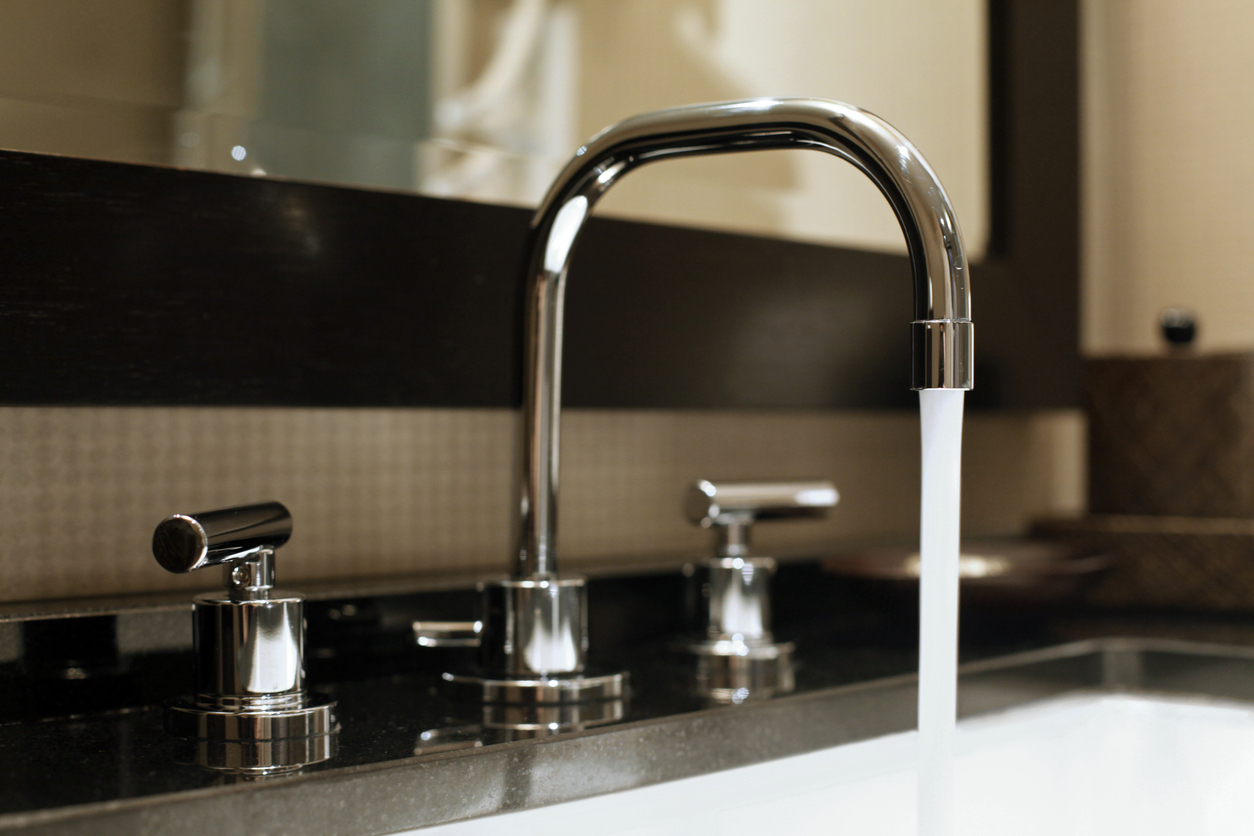
Relieve the pressure in the pipes by draining the water that’s already in them. Turn on a sink located in the lowest level of your home, so water in the pipes from the floors above drain all the way down. Make sure to open both the hot and cold taps and run them until they empty completely. At this point, you can start working on any plumbing projects that require the water to be shut down.
Step 4: After repairs are complete, turn the water back on.
Once you have finished making repairs or your plumbing emergency is no longer a problem, turn the water back on by rotating the valve counterclockwise. The faucet that you previously opened will spit out some air as the water fills the pipes throughout the home. Allow a few minutes for the water to force out any air left in the lines, then turn the faucet off again.
Pro tip: Label the valve for the next time it is needed, and draw arrows that indicate which way to turn in order to shut off and turn on the water.
How to Turn Off the Water Supply to House Fixtures Individually
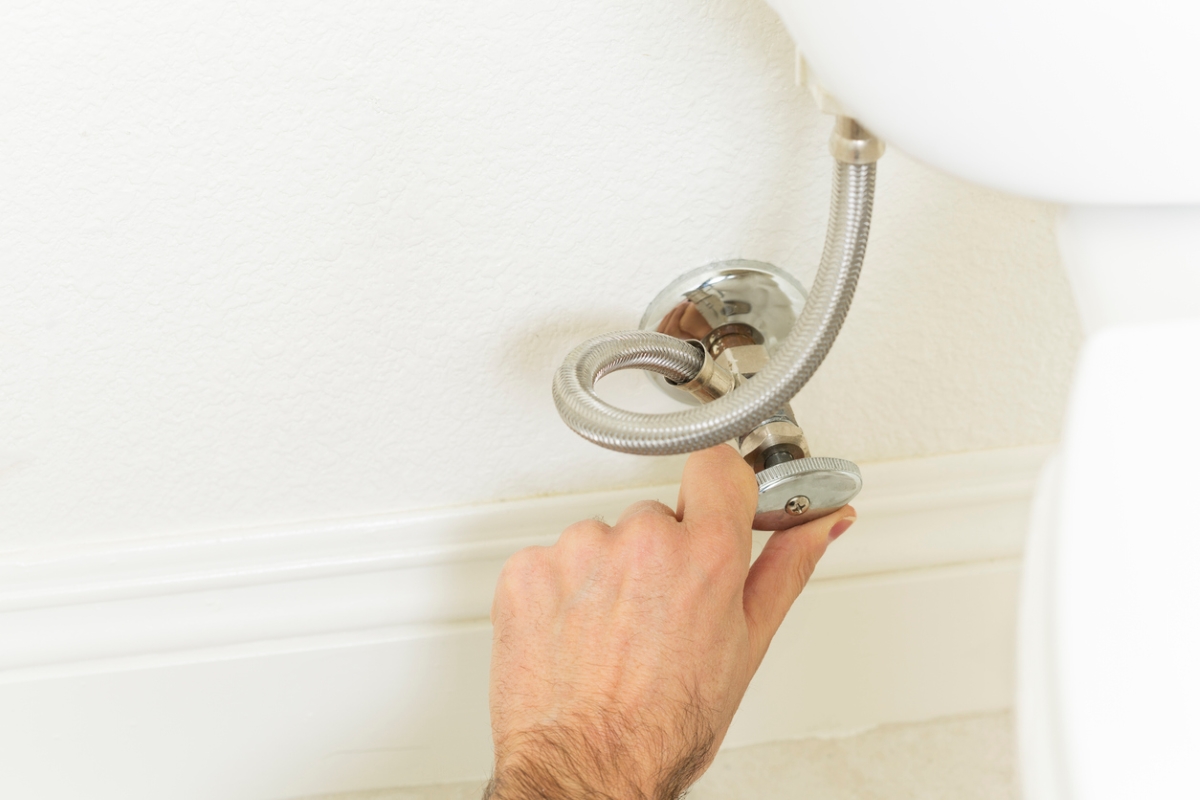
In some cases, it’s more effective to turn off the water to a single faucet or plumbing fixture instead of shutting down the water to the entire home. Not only does this take less time because you don’t need to drain the water from the whole house, but it also allows you to continue using the plumbing in the rest of the home.
For instance, if you are replacing the faucet at the kitchen sink, then you can simply turn off the isolation valve located under the sink, instead of draining the water for the whole home. Similarly, if you need to repair or replace the toilet, dishwasher, or clothes washer, there is typically an isolation valve located nearby that can be operated by hand, without the need for any tools, for these individual fixtures and appliances.
- Dishwasher: The shut-off valve for a dishwasher is generally located inside a lower kitchen cabinet, and it may even be under the kitchen sink depending on the proximity of the dishwasher to the sink in the kitchen layout. Turn off this valve before repairing or replacing the dishwasher to avoid flooding the kitchen.
- Refrigerator: Not all refrigerators have a water line, but for those that do, the shut-off valve is typically located behind the refrigerator. Simply pull the fridge out from the wall to access the shut-off valve before you move, disconnect, or replace the refrigerator.
- Washing machine: In most cases, you can find the shut-off valve behind the washing machine, though it can also be installed off to one side or even above the machine so that it’s easier to access. If you are working on the washing machine or replacing it, then you need to pull it out from the wall anyway. Take this opportunity to turn off the shut-off valve before continuing.
- Sink: Faucet repair and replacement is one of the most common DIY plumbing jobs, so it’s important to know that the isolation valve for these fixtures can generally be found under the sink. In some instances, the hot and cold water lines may have independent valves that need to both be turned off to stop the flow of water through the faucet.
- Toilet: A toilet shut-off valve is usually located behind the toilet or slightly off to one side. This valve can be used to turn off the water when repairing or replacing a toilet, but it can also be used to quickly stop the flow of water into the toilet to prevent it from overflowing in the event of a clog.
Final Thoughts
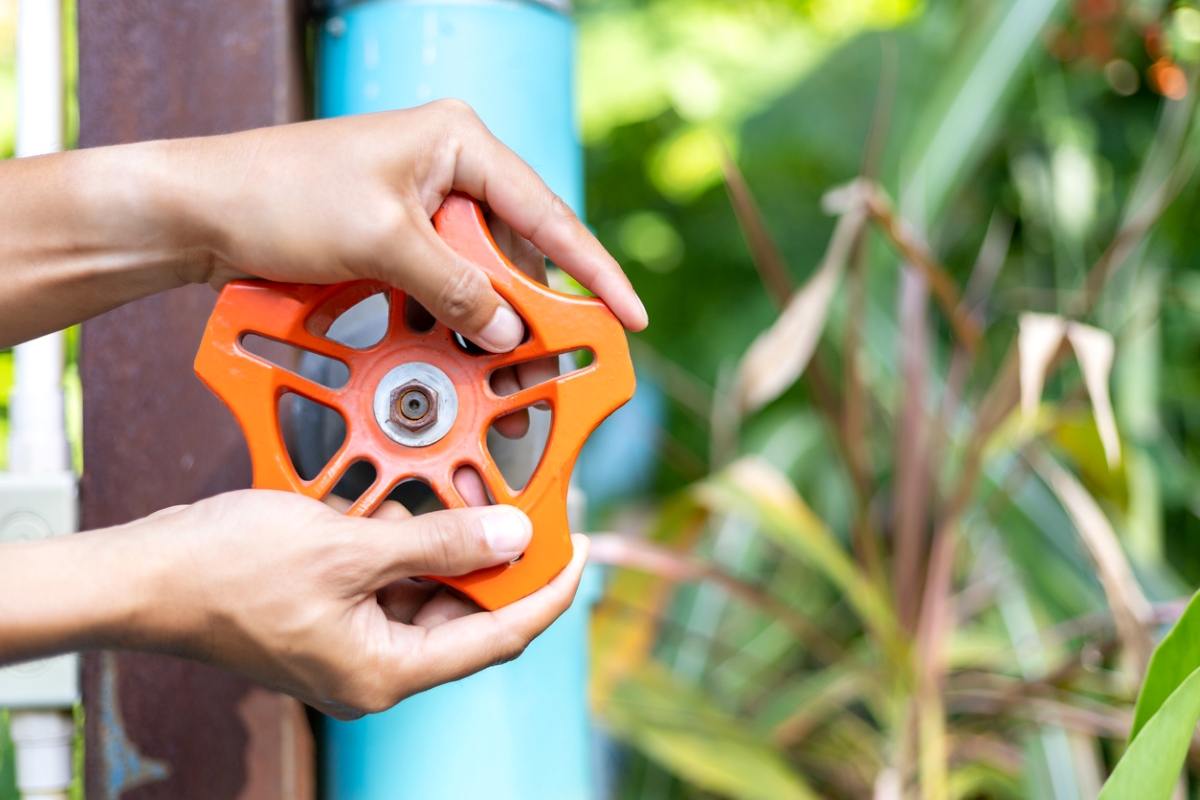
While the purpose of a main shut-off valve is for plumbing infrastructure maintenance, upkeep, and repairs, it’s important to know where this valve is in the event of a leak, flooding, or other plumbing emergencies. If a plumbing fitting starts to leak or a pipe ruptures, it can result in extensive water damage, costly water damage restoration repairs, and ongoing issues with mold and mildew growth.
For this reason, it’s recommended to locate and test your main shut-off valve now, instead of scrambling to try to find it when water is pouring into your home from a broken water line. The valve should work properly without you needing to rely on any emergency plumbing tools. If you find that it is seized or that the valve doesn’t completely shut off the water to the home, then you should contact a plumber to replace the valve.
FAQs
Turning off the water to the home is essential for many plumbing repairs and renovation tasks. Find out more about how to operate this valve with the answers to some of the most frequently asked questions below.
Q. How do I turn water off completely in my house?
The main shut-off valve to the home stops the flow of water into the home, effectively turning off water completely in the house. However, if the main shut-off valve doesn’t work, the water can also be shut off outside at the curbstop, though most municipalities will only allow a licensed plumber or a city official to operate the emergency curbstop valve.
Q. How long should I run water after the shut off?
After turning off the water to the house, you should open a faucet on the lowest level of the home to allow the water left in the pipes to drain. Leave the faucet open while you work. When you turn the water back on, keep the faucet open to give air trapped in the pipes a place to escape. Let the water run for about 5 to 10 minutes, then close the faucet.
Q. What if my main water valve is stuck?
If the main shut-off valve is stuck or seized, you can attempt to loosen it with a set of channel locks or a pipe wrench. Just keep in mind that if you apply too much pressure to the valve, you can break the handle or the stem. In some cases, even if you use a wrench or pliers you will not be able to get the valve moving again. At this point, it’s recommended to call a plumber to replace the valve.
Q. What happens if I flush the toilet while the water valve is off?
When the water is off to the home, it cannot refill the toilet tank. So, if you flush the toilet when the water is off, the water from the tank will empty into the toilet bowl, leaving the tank empty until the water is turned back on. This means that the toilet can be flushed one time, even with the water off, but will not be able to be flushed again until the tank is refilled.
Q. Does shutting off the water affect the water heater?
Turning off the water to the entire home will also stop the flow of water into the water heater. However, if you have a tank-style water heater, then the water inside the tank may still flow out of the water heater. Open a faucet on the lowest level of the home to drain any water remaining in the line. If the hot water continues to flow, locate the isolation valve above the water heater and turn it off to stop the flow of hot water.
